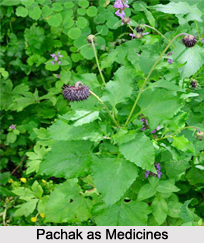 The Aplotaxis auriculata is a native of the mountains around Kashmir and has been used in Hindu medicine from an early age. Its root is described as aromatic, stimulant and useful in cough, asthma, fevers, dyspepsia and skin diseases. It enters also into the composition of some pastiles for fumigation.
The Aplotaxis auriculata is a native of the mountains around Kashmir and has been used in Hindu medicine from an early age. Its root is described as aromatic, stimulant and useful in cough, asthma, fevers, dyspepsia and skin diseases. It enters also into the composition of some pastiles for fumigation.
Agnimukha churna: Take asafoetida, one part Acorus Calamus (vacha) 2 parts, long pepper 3 parts, ginger 4 parts, ajwain 5 parts, chebulic myrobalan 6 parts, plumbago root 7 parts and the root of Aplotaxis auriculata 8 parts. Powder the ingredients, mix and pass the powder through a cloth. Dose is 20 to 40 grains with whey or wine in dyspepsia with loss of appetite.
A liniment composed of the root of Aplotaxis auriculata, Kanjika and castor oil is recommended by several writers to be applied to the forehead in cephalalgia. The fried root, mixed with mustard oil, is applied to the scalp in porrigo. Equal parts of the powdered root and of rock salt, mixed with mustard oil and fermented paddy water (Kanjika) are rubbed on joints affected with chronic disease.
This article is a stub. You can enrich by adding more information to it. Send your Write Up to content@indianetzone.com
Related Articles
Ayurveda
Origin of Ayurveda
Ayurveda Medication
Elements of Ayurveda
Concepts of Ayurveda
Ancient Literature of Ayurveda
Sushruta Samhita




















